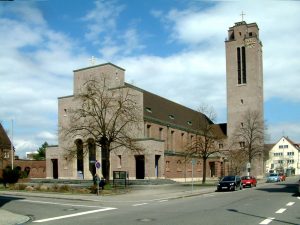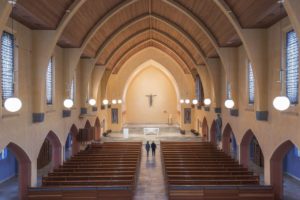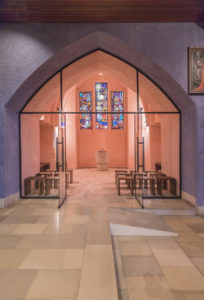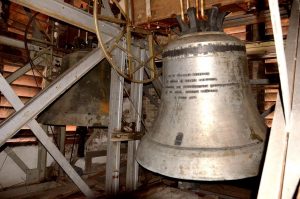|
The basilica is designed in the Bauhaus style and has a bold architectural structure. The nave and side aisles have cubic extensions off the west side. The building has a 46-metre-high tower, which has four-tone chimes and, along with the west front, is completely lined with bricks. The west front has three high archways, and above them a monolithic crucifixion group designed by Professor Rieber from Munich, both of which are made of shell limestone. Beneath the archways, there are three doorways, with a relief sculpture of St. Petrus Canisius above the middle entrance. Above the west entrance, there is an emblem relief of Bishop Joannes Baptista Sproll. |
 |
Church Interior
The church is a three-aisled basilica with narrow, high windows. The side aisles have been designed to be low and covered. The 58-metre-long nave extends beneath large, pointed arches, and ends at the front of the church with a relatively small choir at the east wall. The nave is bordered by seven alcoves on each side, which form arches pointing towards the windows. There are also three such alcoves at the back of the church, above which the gallery with the Woehl organ is located.
The interior was designed by artist August Blepp, who made use of color in particular to increase its spatial impact; inside the church, you move from the deep blue of the side aisles, through the earth tones of the archways, and into a bright yellow-gold hall. The right sidewall is adorned with a large, stone Sacred Heart of Jesus statue, sculpted by Tony Schneider-Manzell, from the village of Manzell. |
 |
Sanctuary
The sanctuary resides over two levels and has the two most important liturgical places of every church at its center: the ceramic altar and the ambo, which were designed by Munich-born artist Susanne Wagner. On the upper level, you will find the tabernacle with the Most Blessed Sacrament, the lasting presence of Christ in the Eucharist bread, indicated by the sanctuary lamp. Six archways, reminiscent of choir stalls, can be seen on both the left and the right of the sanctuary. Schneider-Manzell’s large statue of the crucified Christ, affixed to the east wall, overlooks the sanctuary. Large windows flood the upper part of the sanctuary with light. Two lowered side altars, each with a relief of St. Maria Immaculate and Andrew the Apostle from Georg Thuma’s workshop, are found in the choir. |
 |
Baptistry and Transept
At the base of the tower there is a chapel, which features a magnificent glass window depicting the baptism of Christ in Jordan, designed by Emil Glückler, from Untertürkheim, and is also the parish’s baptismal center where Professor Rieber’s baptismal font can be found. The left transept contains the sacristy. Moving from the chancel to the nave, there are two simple side altars, above each of which are pictures from the former convent of Löwental. The left picture depicts the vision of St. John of Nepomuk, and the right picture depicts the death of St. Joseph. In the first arch of the central aisle, you will find what is commonly called the Löwentaler Heiligenhimmel, a large painting from the former convent of Löwental, depicting several saints from our nearby surroundings alongside St. Dominic and St. Catherine of Alexandria. |
 |
Other Artworks
The fourteen stations of the cross, painted by August Blepp in the church colors, are found in the side aisles. At the back of the church, there are some sculptures, including one of St. Jude Thaddeus, one of St. Anthony of Padua, and a pietà from the fifteenth century.
A lot of the church’s details have been artistically integrated into the church building, including its different lampstands, its handholds, and the holy water font, and add to the overall impression of the church being a multi-layered collective artwork.
Every year at Christmas, the historic manger is taken from the Osterrieder’s workshop and placed in the chancel. |
 |
Church Bells
The bells of St. Petrus Canisius’ were consecrated for the church in 1928. During the Second World War, all bar one of the bells had to be handed over. Most of the bells were restored in the 1950s. The largest bell (A) was donated by H. Karl Fränkel in 1988, once again completing the ensemble.
Click on this link to see and hear the bells in action.
|
 |
